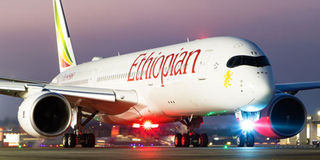Open skies would lead to growth of Africa’s airlines

Expensive. Air transport continues to be expensive due to limited regulated access of different countries airspace across the continent. FILE PHOTO
What you need to know:
- The only airline that has recorded success on the African continent is Ethiopian: Its net profit in the 2017/18 financial year rose almost 2 per cent to $233m.
- All other regions are expected to report profits in 2018 and 2019, with carriers in North America continuing to lead on financial performance, accounting for nearly half of the industry’s total profits.
- Financial performance is expected to improve from 2018 in all regions except Europe, where improvement has been delayed by increased fuel hedging.
Nairobi. Experts at the aviation summit in Kigali said African governments will need to depoliticise aviation, shelve sovereignty and support airlines financially to build stronger inter-bloc co-operation.
Up to 397 African airlines have gone under since 1960, and more could shut down if they don’t evolve fast.
Aviation industry captains and regulators have been pushing for open skies and making air transport affordable in Africa, but these have largely remained pipe dreams even as the number of new flyers grows.
For most Africans, it takes about three weeks’ salary on average to travel by air on the continent, whereas it takes only a three-day salary to fly the same distances in other parts of the world such as Europe and the US.
African airlines incur the highest operational costs globally due to prohibitive fuel costs, taxes and other charges, unfriendly customs regimes and monopolistic environments.
Although up to 28 countries have already signed up to the Single African Air Transport Market (SAATM) treaty, only two have implemented it fully.
“It is a form of colonial hangover that many countries still suffer from. It’s just a matter of time and everyone will see the benefits of an open air space and join,” said Ladislaus Matindi, the chief executive officer of Air Tanzania.
African airlines were accused of neglecting co-operation with others on the continent in maintenance, training and operational services, opting to work with foreign airlines instead.
“Even when requesting additional frequencies or stops, you are blocked in many African countries. There is no way we are going to advance if we are working in isolation. We need to put the formula right, and fast,” said Rwandair chief executive officer Yvonne Makolo.
Intra-African connectivity has fallen to its lowest in 10 years at just 43 per cent, from 46.6 per cent in 2007.
In Europe it is 67 per cent, in south east Asia (ASEAN) it is 79 per cent, and in North America it is 78 per cent.
One of the fears have always been that when African countries open their skies to their peers, their smaller airlines will be cannibalised by big players, something Girma Wake, an African airline expert, disputes.
“Open skies serve both the big and smaller airlines better if they work together. The smaller ones should serve their markets to grow their traffic,” said Mr Girma, who is a board member of Ethiopian Airlines.
The International Air Transport Association (IATA) in its recent forecasts predicted that Africa would remain the weakest airline region in the world in 2019.
African carriers are expected to report a $300m net loss in 2019 - slightly improved from the $400m net loss in 2018, with an expected net loss per passenger of $3.51.
The only airline that has recorded success is Ethiopian: Its net profit in the 2017/18 financial year rose almost 2 per cent to $233m.



